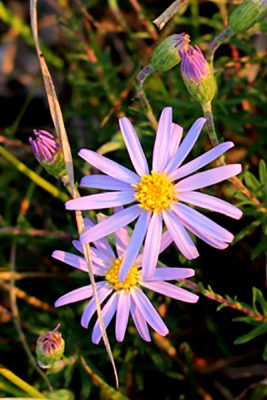Flax-leaved stiff aster (Ionactis linarifolia)
I first encountered flax-leaved stiff aster, Ionactis linarifolia, while walking through the parking lot at the Wells Reserve in Wells, Maine. Situated at the edge of the parking area, its low, mounded habit with neat, erect sprays of lavender daisy-like flowers caught my eye among the taller grasses and gray-green leaves of pussy toes. How had I never seen this gem before?

Stiff aster has many common names, including “bristly aster,” for its spruce-like leaves that feel rough to the touch; “flax-leaved aster” for the leaves’ resemblance to flax; and “ankle aster” for small stature of these plants that tickle your ankles when you walk through them. The plants grow up to twelve inches and flower colors range from medium purple to pale, sometimes white. Leaves maintain their green color throughout the growing season, turning varied shades of purple, orange, or yellow after flowers bloom. Stiff aster is found in dry, sandy areas, including manmade or disturbed areas, meadows, grasslands, fields, and the shores of lakes and rivers. The plant is native to Maine, with an expansive range covering the eastern United States and southern Canada.
Asters are top host plants for butterfly and moth caterpillars, second only to goldenrods. They provide pollen and nectar to many kinds of insects including bees, flies, butterflies, moths, skippers, and beetles. Several animals, including the ruffed grouse, wild turkey, cottontail rabbit, and mice, eat the seeds and leaves. Supporting small mammals provides an important food source for hawks, owls, fox, and other animals in the food chain.
Stiff aster is a great plant for the home garden when planted in dry or gravelly soil. If you have lovely, rich garden soil, this is not your plant. It does not tolerate moist, fertile conditions. As a border plant, stiff aster fills in a garden bed nicely, creating a carpet of delicate blooms in late summer to early fall. Pair with other plants that tolerate similar conditions, such as butterfly milkweed, sundial lupine, spotted beebalm, little bluestem, and downy goldenrod for a lovely mid to late summer display. Stiff aster is a good choice for making seed balls, which is an easy, fun way to reintroduce native plants to bare areas. They offer a great opportunity to get together with others, make mud balls, and hurl them into clearings, along roadsides, or into your own garden. Such joy!
Growing stiff aster
Stiff aster is easily grown from seed. To grow your own, plant seeds in a pot outdoors in the fall or winter. The wet, cold conditions mimic wild seed propagation in nature and the seeds will germinate mid-spring. To learn more about growing and sowing the seeds of native plants, read our blog on fall and winter seed sowing.
What’s in a name? Ionactis linarifolia
The genus, Ionactis, comes from the Greek word, “ion,” meaning “violet,” and “atkis,” meaning “ray.” The species, linarifolia, refers to the flax-like leaves. Aster flowers are edible and can be used fresh in salads or as a garnish. They are often combined in mixed tea blends.
by Ginger Laurits
Ginger Laurits is a former Wild Seed Project board member who tends the native garden at the Wells Reserve.

